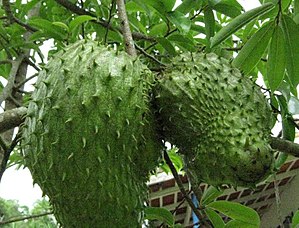Note: This is a project under development. The articles on this wiki are just being initiated and broadly incomplete. You can Help creating new pages.
Difference between revisions of "Annona Muricata"
| Line 2: | Line 2: | ||
'''Annona muricata''' is a fast-growing, small, evergreen tree. It can reach a height of about 7 metres. The bole can be up to 15cm in diameter. The tree is widely cultivated in tropical regions for its edible fruit. | '''Annona muricata''' is a fast-growing, small, evergreen tree. It can reach a height of about 7 metres. The bole can be up to 15cm in diameter. The tree is widely cultivated in tropical regions for its edible fruit. | ||
==Uses== | ==Uses== | ||
| − | {{Uses|Distension}}, {{Uses|Dyspepsia}}, {{Uses|Scabies}}, {{Uses|Skin diseases}}, {{Uses|Rheumatism}}, {{Uses|Coughs}}, {{Uses|Colds}}, {{Uses|Digestive tract ailments}}, {{Uses|Relieve fatigue}}, {{Uses|Maturate boils}}, {{Uses|Abscesses}}, {{Uses|Nervous shock}}, {{Uses|Bedwetting}} | + | {{Uses|Distension}}, {{Uses|Dyspepsia}}, {{Uses|Scabies}}, {{Uses|Skin diseases}}, {{Uses|Rheumatism}}, {{Uses|Coughs}}, {{Uses|Colds}}, {{Uses|Digestive tract ailments}}, {{Uses|Relieve fatigue}}, {{Uses|Maturate boils}}, {{Uses|Abscesses}}, {{Uses|Nervous shock}}, {{Uses|Bedwetting}}<ref name="Karnataka Medicinal Plants"/> |
==Parts Used== | ==Parts Used== | ||
| − | {{Parts Used|Fruit}}, {{Parts Used|Young shoot}}, {{Parts Used|Leaf}} | + | {{Parts Used|Fruit}}, {{Parts Used|Young shoot}}, {{Parts Used|Leaf}}<ref name="Karnataka Medicinal Plants"/> |
==Chemical Composition== | ==Chemical Composition== | ||
| Line 11: | Line 11: | ||
==Common names== | ==Common names== | ||
| − | {{Common names|sa=|gu=|hi=Lakshmana Phal|kn=Mullu Ramphala|ta=Mulluchitta|te=Lakshmana Phalam|en=Soursop}} | + | {{Common names|sa=|gu=|hi=Lakshmana Phal|kn=Mullu Ramphala|ta=Mulluchitta|te=Lakshmana Phalam|en=Soursop}}<ref name="Karnataka Medicinal Plants"/> |
==Properties== | ==Properties== | ||
| Line 72: | Line 72: | ||
<ref name="Leaf">[Morphology]</ref> | <ref name="Leaf">[Morphology]</ref> | ||
<ref name="How to plant/cultivate">[Cultivation]</ref> | <ref name="How to plant/cultivate">[Cultivation]</ref> | ||
| + | <ref name="Karnataka Medicinal Plants">"Karnataka Medicinal Plants Volume - 3" by Dr.M. R. Gurudeva, Page No.1108, Published by Divyachandra Prakashana, #45, Paapannana Tota, 1st Main road, Basaveshwara Nagara, Bengaluru. </ref> | ||
</references> | </references> | ||
Latest revision as of 18:31, 8 January 2024
Annona muricata is a fast-growing, small, evergreen tree. It can reach a height of about 7 metres. The bole can be up to 15cm in diameter. The tree is widely cultivated in tropical regions for its edible fruit.
Contents
- 1 Uses
- 2 Parts Used
- 3 Chemical Composition
- 4 Common names
- 5 Properties
- 6 Habit
- 7 Identification
- 8 List of Ayurvedic medicine in which the herb is used
- 9 Where to get the saplings
- 10 Mode of Propagation
- 11 How to plant/cultivate
- 12 Commonly seen growing in areas
- 13 Photo Gallery
- 14 References
- 15 External Links
Uses
Distension, Dyspepsia, Scabies, Skin diseases, Rheumatism, Coughs, Colds, Digestive tract ailments, Relieve fatigue, Maturate boils, Abscesses, Nervous shock, Bedwetting[1]
Parts Used
Chemical Composition
The plant contains isoquinoline alkaloids including reticuline. The seed contains galactomannan, sitosterol, stigmasterol and cholesterol[2]
Common names
| Language | Common name |
|---|---|
| Kannada | Mullu Ramphala |
| Hindi | Lakshmana Phal |
| Malayalam | NA |
| Tamil | Mulluchitta |
| Telugu | Lakshmana Phalam |
| Marathi | NA |
| Gujarathi | |
| Punjabi | NA |
| Kashmiri | NA |
| Sanskrit | |
| English | Soursop |
Properties
Reference: Dravya - Substance, Rasa - Taste, Guna - Qualities, Veerya - Potency, Vipaka - Post-digesion effect, Karma - Pharmacological activity, Prabhava - Therepeutics.
Dravya
Rasa
Guna
Veerya
Vipaka
Karma
Prabhava
Habit
Identification
Leaf
| Kind | Shape | Feature |
|---|---|---|
Flower
| Type | Size | Color and composition | Stamen | More information |
|---|---|---|---|---|
| Flowering season is July to January |
Fruit
| Type | Size | Mass | Appearance | Seeds | More information |
|---|---|---|---|---|---|
| Fruiting season is July to January |
Other features
List of Ayurvedic medicine in which the herb is used
Where to get the saplings
Mode of Propagation
How to plant/cultivate
Grows best in the moist, humid tropical and subtropical lowlands at elevations up to about 1,000 metres. It prefers a mean annual temperature in the range 25 - 30°c with a mean annual rainfall over 1,000mm.[4]
Commonly seen growing in areas
Found on coastal limestone, Lowland woodland.
Photo Gallery
References
External Links
- Ayurvedic Herbs known to be helpful to treat Distension
- Ayurvedic Herbs known to be helpful to treat Dyspepsia
- Ayurvedic Herbs known to be helpful to treat Scabies
- Ayurvedic Herbs known to be helpful to treat Skin diseases
- Ayurvedic Herbs known to be helpful to treat Rheumatism
- Ayurvedic Herbs known to be helpful to treat Coughs
- Ayurvedic Herbs known to be helpful to treat Colds
- Ayurvedic Herbs known to be helpful to treat Digestive tract ailments
- Ayurvedic Herbs known to be helpful to treat Relieve fatigue
- Ayurvedic Herbs known to be helpful to treat Maturate boils
- Ayurvedic Herbs known to be helpful to treat Abscesses
- Ayurvedic Herbs known to be helpful to treat Nervous shock
- Ayurvedic Herbs known to be helpful to treat Bedwetting
- Herbs with Fruit used in medicine
- Herbs with Young shoot used in medicine
- Herbs with Leaf used in medicine
- Herbs with common name in Kannada
- Herbs with common name in Hindi
- Herbs with common name in Tamil
- Herbs with common name in Telugu
- Herbs with common name in English
- Habit - Evergreen Tree
- Index of Plants which can be propagated by Seed
- Index of Plants which can be propagated by Semi ripe cutting
- Herbs that are commonly seen in the region of Found on coastal limestone
- Herbs that are commonly seen in the region of Lowland woodland
- Ayurvedic Medicine
- Pages without herbs images






